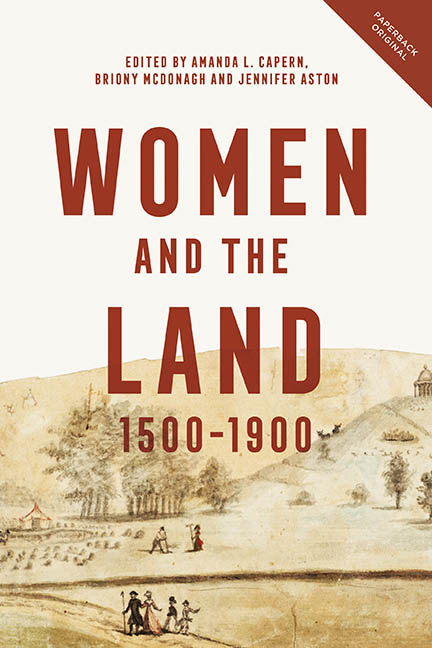Book contents
- Frontmatter
- Contents
- List of Illustrations
- List of Contributors
- Introduction: Women, Property and Land
- 1 Women, Work and Land: The Spatial Dynamics of Gender Relations in Early Modern England 1550–1750
- 2 Spinsters with Land in Early Modern England: Inheritance, Possession and Use
- 3 Becoming Anne Clifford
- 4 The Heiress Reconsidered: Contexts for Understanding the Abduction of Arabella Alleyn
- 5 From Magnificent Houses to Disagreeable Country: Lady Sophia Newdigate's Tour of Southern England and Derbyshire, 1748
- 6 On Being ‘fully and completely mistress of the whole business’: Gender, Land and Estate Accounting in Georgian England
- 7 Negotiating Men: Elizabeth Montagu, ‘Capability’ Brown and the Construction of Pastoral
- 8 Women's Involvement in Property in the North Riding of Yorkshire in the Eighteenth and Nineteenth Centuries
- 9 Invisible Women: Small-scale Landed Proprietors in Nineteenth-century England
- 10 More than Just a Caretaker: Women's Role in the Intergenerational Transfer of Real and Personal Property in Nineteenth-century Urban England, 1840–1900
- Afterword
- Select Bibliography
- Index
- PEOPLE, MARKETS, GOODS: ECONOMIES AND SOCIETIES IN HISTORY
1 - Women, Work and Land: The Spatial Dynamics of Gender Relations in Early Modern England 1550–1750
Published online by Cambridge University Press: 21 March 2020
- Frontmatter
- Contents
- List of Illustrations
- List of Contributors
- Introduction: Women, Property and Land
- 1 Women, Work and Land: The Spatial Dynamics of Gender Relations in Early Modern England 1550–1750
- 2 Spinsters with Land in Early Modern England: Inheritance, Possession and Use
- 3 Becoming Anne Clifford
- 4 The Heiress Reconsidered: Contexts for Understanding the Abduction of Arabella Alleyn
- 5 From Magnificent Houses to Disagreeable Country: Lady Sophia Newdigate's Tour of Southern England and Derbyshire, 1748
- 6 On Being ‘fully and completely mistress of the whole business’: Gender, Land and Estate Accounting in Georgian England
- 7 Negotiating Men: Elizabeth Montagu, ‘Capability’ Brown and the Construction of Pastoral
- 8 Women's Involvement in Property in the North Riding of Yorkshire in the Eighteenth and Nineteenth Centuries
- 9 Invisible Women: Small-scale Landed Proprietors in Nineteenth-century England
- 10 More than Just a Caretaker: Women's Role in the Intergenerational Transfer of Real and Personal Property in Nineteenth-century Urban England, 1840–1900
- Afterword
- Select Bibliography
- Index
- PEOPLE, MARKETS, GOODS: ECONOMIES AND SOCIETIES IN HISTORY
Summary
This chapter explores the neglected topic of the spatial experience of rural women in early modern England. Much has been written about the history of the work of men and women in the pre-modern past. It is now generally acknowledged that early modern ideological assumptions about a strict division of work and space between men and productive work outside the house on the one hand, and women and reproduction and consumption inside the house on the other, bore little relation to reality. Household work strategies, out of necessity, were very diverse. Women were employed in a wide range of productive occupations, if to a more limited degree, within and beyond the home and most men worked in, near or from the house, as people rarely had a separate workplace away from home. Boundaries were further complicated by the frequent employment of servants who lived and worked alongside families on close and fairly intimate terms. What this spatial complexity meant for ordinary women and men on a day-to-day basis and its consequences for gender relationships is less clear and has received relatively little historical attention. In particular, and of relevance to this essay, while a significant historiography exists on female agricultural labour, few historians have examined how ordinary women used space in a rural context or how, during a period in which agrarian capitalism was undergoing significant transformation, women's experience of the landscape was changing. Indeed, at least implicitly, the landscape in early modern England has been presented in largely male terms, stressing the activities of male workers and marginalising women's presence. This is in part perhaps because it has been assumed that the English legal system generally discouraged female property ownership and so there has been only limited research on women's management and control of land. A focus on women's paid labour in the literature alongside a tendency to include women's unpaid occupations under the general label of domestic has also tended to suppress awareness of and interest in the variety of female spatial experiences in the sixteenth and seventeenth centuries.
This essay attempts to redress the balance and to add to our knowledge through a case study of the way that women used and experienced rural space for work in the county of Essex during the ‘long seventeenth century’.
- Type
- Chapter
- Information
- Women and the Land, 1500–1900 , pp. 29 - 50Publisher: Boydell & BrewerPrint publication year: 2019



